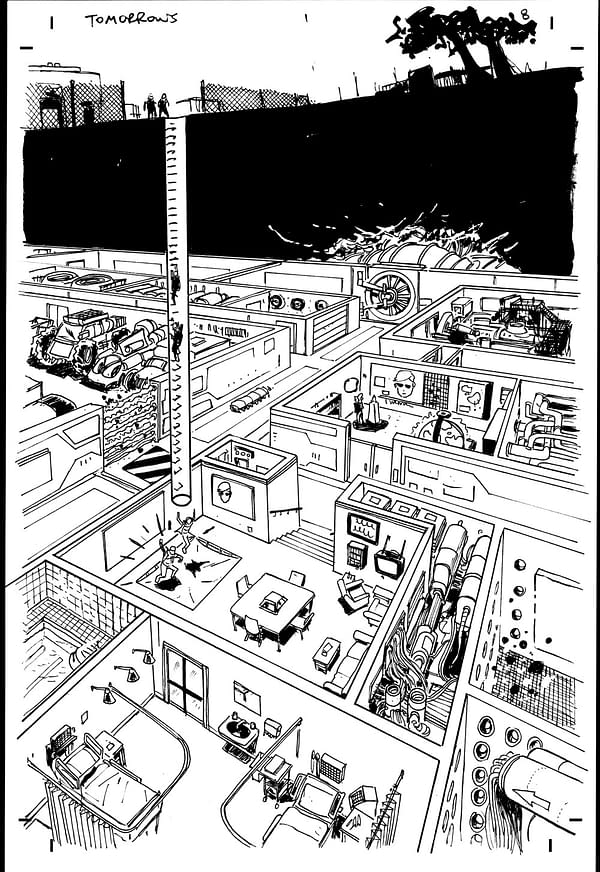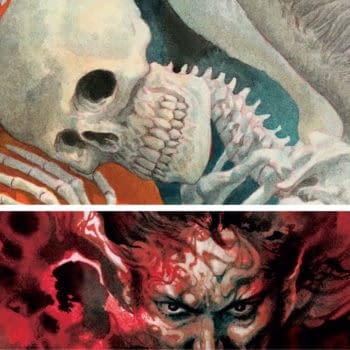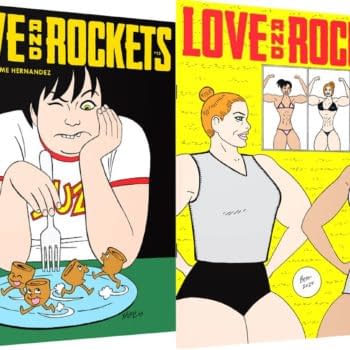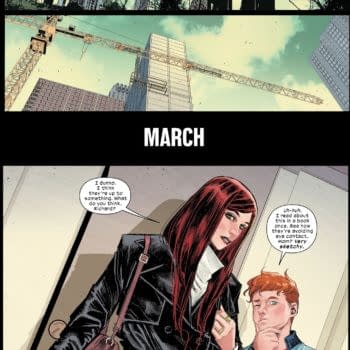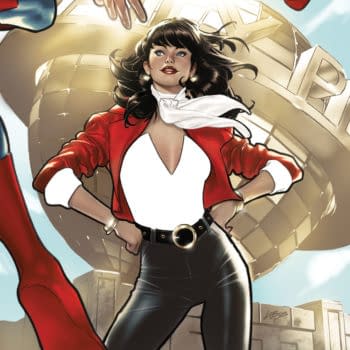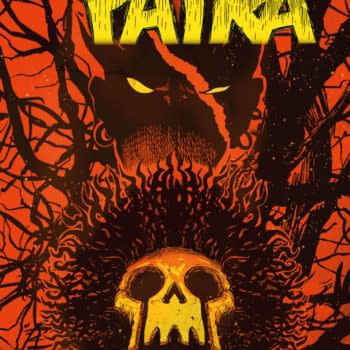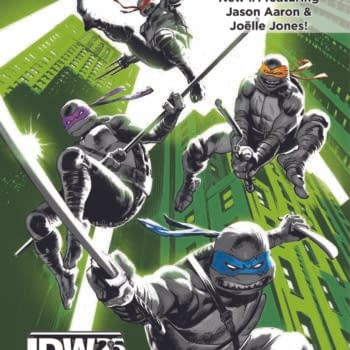Posted in: Comics, Recent Updates | Tagged: boom, Comics, Curt Pires, dark horse, David Rubin, entertainment, Jason Copland, moebius, pop, the fiction, The Tomorrows
'The Fascinating Interplay Between Fiction And Reality' Brings Us The Fiction And The Tomorrows – Curt Pires In The Bleeding Cool Interview
Curt Pires is a very busy man in 2015, and looks like he will be in 2016 as well. Building on the momentum he gained working on the critical success POP from Dark Horse and Mayday from Black Mask Studios, he is the writer of two new series arriving this summer, The Fiction from Boom! Studios and The Tomorrows published by Dark Horse. In many ways you couldn't find two more different comic series or approaches to the medium, but those who look closely at the content might recognize some ideas and themes Pires concerns himself with in comics so far, taking them to new levels. In The Fiction, which is drawn by David Rubín and colored by Michael Garland, we find that a beloved fantasy literature construct, children who are able to enter books and experience new worlds, is twisted pretty neatly into a new shape by making things rather dark and double-edged, especially when those kids grow up. In The Tomorrows, Pires will be working with a new artist on each issue of the series about an invasive governmental role in society, using social media information to control citizens and focusing on characters poised to rebel as both art forms and free thinking are rendered illegal. The first issue will be drawn by Jason Copland.
Some of the features I found of interest in The Fiction and The Tomorrows involved using all-ages themes in a subversive way, using strong visual language to create narrative structure, and the modes by which comics can speak to our modern situation in a very immediate way. Because Curt Pires tends to be adept at fielding the strangest of questions and seems to relish fairly abstract thinking as well as practical detail, I put together quite a cocktail of topics for him here in our Bleeding Cool interview.
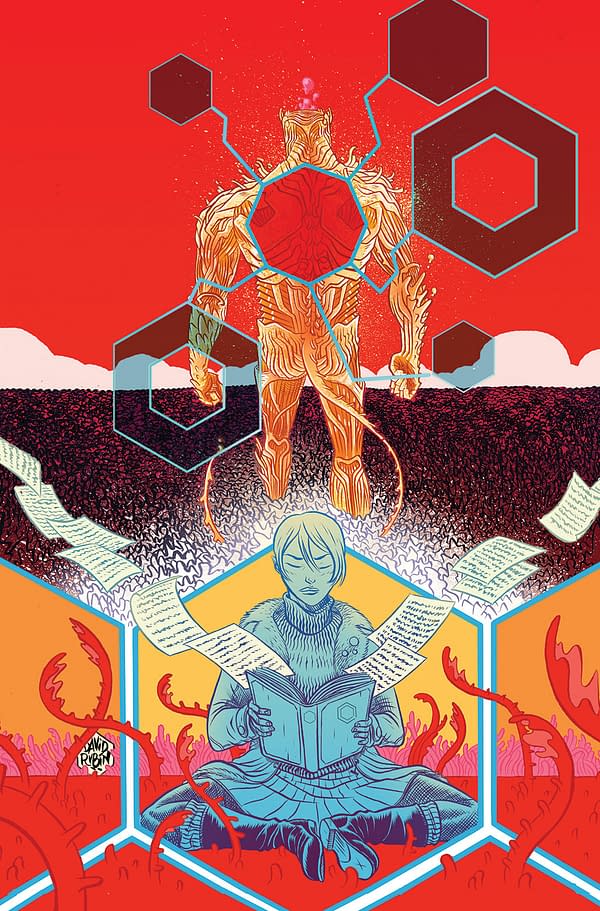
Hannah Means-Shannon: To start with some fairly off the wall questions, Curt, what is it that comics can do that interests you the most? When I ask people what they like about the medium, they often say, "Comics can do anything", which I believe is accurate.
But could you be specific about some things that are surprising about narrative potential in comics you've discovered? I ask this because you are not exactly conservative in your comic formats.
Curt Pires: I'm interested in particular in the ways that I can use comics to process abstract thoughts and feelings within me. Things I have a hard time processing, or reconciling, comics is my language. I can tackle these issues. I'm also fascinated with the interplay between fiction and reality. How one can alter the other, or at least be a conduit for change, both on a personal scale and on a global one. I think they're a channel for us to put beautiful, wondrous ideas into the world, and see what takes route.
HMS: What is the most outrageous comic you've ever read that nevertheless kept you on board even though it challenged you? By that I think I mean that it somehow maintained your suspension of disbelief against the odds.
CP: I don't generally have issues suspending my disbelief, especially when it comes to comics, but I think the trippiest comic I've ever read has to be The Incal by Jodorowsky and Moebius. That comic just feels like taking acid. It just throws you in the deep end and doesn't ever let up. It's such a fun and magical piece of work. I love it.
HMS: Who are three comic heroes of yours, whether writers or artists?
CP: Hard to do just three so I'm going to cheat.
Writers: Morrison, Gaiman, Ellis, Moore. British Invasion, I guess. They left a huge mark on me, and on the industry as a whole if we're being honest.
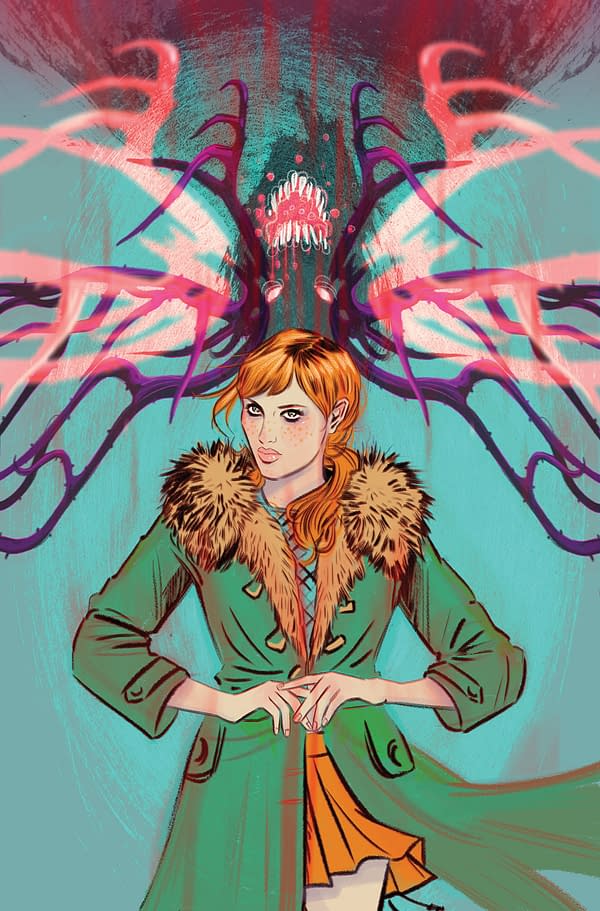
HMS: Regarding The Fiction, is an all-ages comic? If so, did you feel you had to keep that in mind when writing it? If not, why not?
CP: I didn't ever think of The Fiction as an all ages book when I was writing it, but it somehow ended up being one. My contract with Boom! stipulated that the book had to be PG 13 and I didn't bother to get my lawyer to negotiate a more mature rating, so I just ended up playing in that sandbox. It was fun. I think what makes The Fiction such a great all ages book is that it's not afraid of big ideas, or confronting children with a little darkness—with giving them something to contemplate. At the same time it doesn't get boring for the adults. It's truly a comic that can be enjoyed by basically everyone.
HMS: I've noticed that sometimes you use objects and locations to tie a narrative together even when there's not an overwhelmingly signposted narrative thread.
By that I mean following an object from one panel to another. In The Fiction #1, there's a door, then a keyhole, then moving inside the keyhole to the other side in the room, for instance.
Or am I totally wrong and are the artists developing that? My question is: how visually do you plot your comics?
CP: This definitely ties back to your earlier question about influences. One thing I learnt early on from just reading and ingesting comics is that the best comics are the ones that invent a symbolic language that bridges the gap between the script and the art. The way Moore and Gibbons utilize symbolism within Watchmen. Building images across panels, by pulling out, zooming in. Morrison does this too. When I think about what Neil Gaiman and JH Williams are doing right now on Sandman it's the same thing, it's this language that is created between the writer and artist. It's the true magic of comics I think and Rubin and I definitely plugged into it in the specific case your mentioning, and in general. So to answer the question: I'm always thinking about visually plotting the comics. Hell, I built POP around a yin/yang structure. The first and last pages are mirrors.
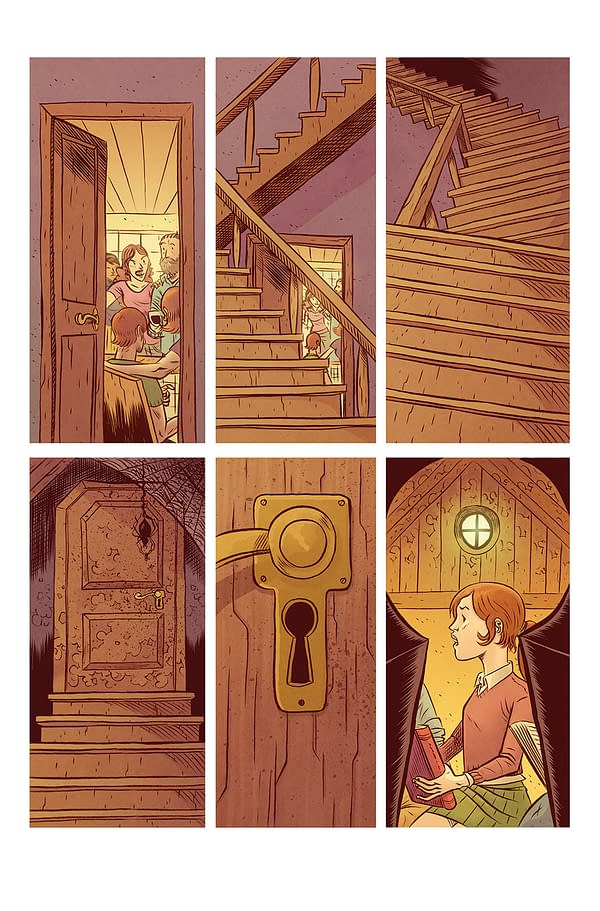
HMS: There's a double-edged, interesting combination of features in The Fiction as far as I can tell, with some lighter, more whimsical elements that might hail from literary tradition where children come to inhabit literature or change realms like in Alice in Wonderland or Peter Pan (or even Narnia), but there's the idea that things can seem fun and light to kids and then suddenly they aren't fun anymore. Why write about that alternation? How does this continue to apply to adult life, do you think?
CP: You absolutely nailed it. The mythology of these types of places ties into the heart of what The Fiction is. Charles Dodgson becomes a character in the book at some point…
Why write about this? Because I think there's a huge amount of truth in this dichotomy. When we're children the entire world is magical. Everything is an adventure. The way the sun shines. The first time I saw a puppy. The first time you're smitten with a member of the opposite sex. We spend our early lives being engulfed and in love with the magic in the universe, and slowly, we grow older and reality does it's best to drain the magic out. To make us unimpressed with the things around us. But the magic's still there. We just have to find it.
The flip side of this magic though, is that there's always a darkness to it. The only way we can perceive/understand the beauty of the world is if we have something to contrast it to, so In that regard I wanted to explore this dichotomy, see what was at the heart of it all.
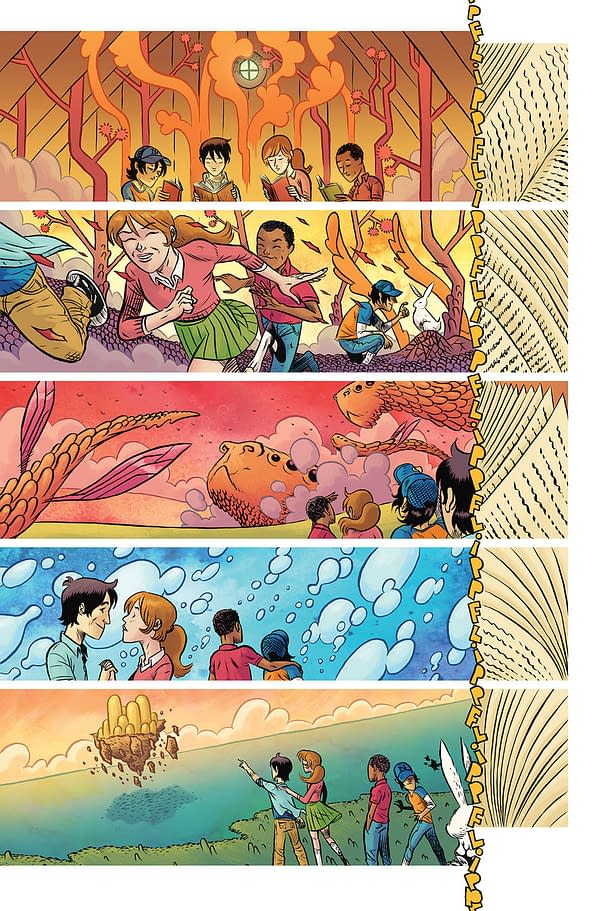
HMS: Regarding The Tomorrows, what doors do you think it opens in comics storytelling to have a different artist on each issue of a comic? What does that actually do for narrative and continuity (assuming those are the goals)?
CP: It lets me have a lot of fun with collaboration. I think that's the first thing. That's a selfish answer, but it's true. In terms of the narrative, it allows me to really embrace the collaborative nature of comics. I don't know about you, but the comics I've always loved are ones that are made by a team firing on all cylinders. Comics where the art is exciting and the story is filled with concepts and ideas and beauty.
So The Tomorrows is really me embracing everything I love about comics and diving in. We have our planned narrative, our story structure, but we also have all these opportunities to have fun and showcase what's so wonderful about these artists. It's a little like having your cake and eating it too.
In terms of continuity, we're constantly sharing assets, the work the artists are doing with all the other artists so it's a little bit like passing a baton. We want a visual continuity of sorts, but we're also embracing what makes each of these artists different and wonderful.
[Cover art for The Tomorrows #1 by Jason Copland]
HMS: Don't take this the wrong way, but there's a trend emerging in some of your comics to both map out a system and distrust that system greatly. It's almost like it has to be properly mapped to be properly distrusted.
Why write about the little people against the backdrop of big, conglomerate identities? What does that mean to you as a person? What do you most want to say thereby?
CP: I mean, I think a lot of it is just how I process the world we live in, to be honest. Government and Corporations are so intertwined in American at this point that it's getting harder and harder to distinguish. America as a country has state sanctioned murders in the form of police officers. The Homan Square black site in Chicago. The Patriot Act. NSA mass surveillance. This stuff isn't science fiction, it's reality. I try and write my way out of it a lot of the time, because honestly, I feel like I'm suffocating. I look at the world we live in, and it's just too much sometimes.
So I use my comics to process it. There's a flip side to that too—where in my comics you see me explore how beautiful reality can be. That's a really important dichotomy to me. Sure the world can be dark, evil, sinister—but around every corner there's something that'd take your breath away, make you smile, make you fall in love all over again.
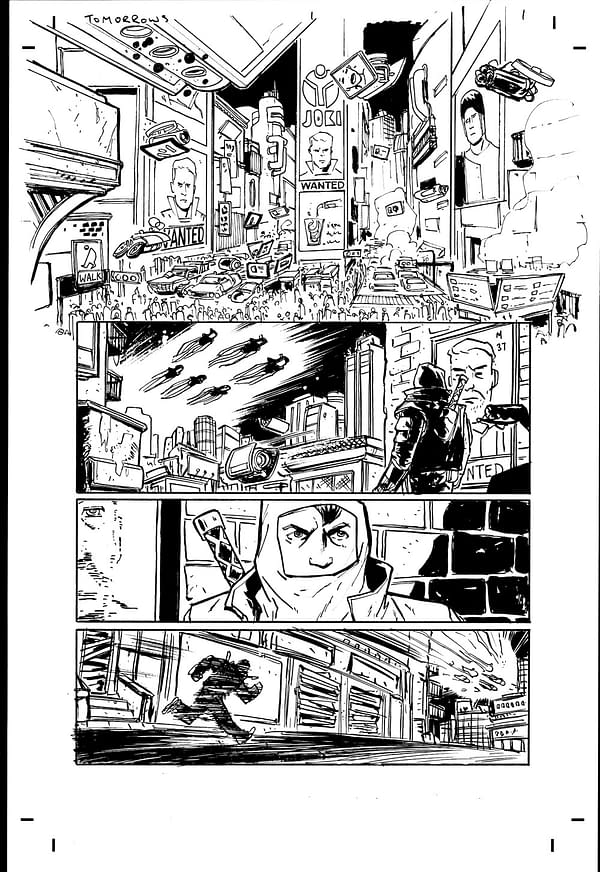
HMS: I think it probably is true that with the amount of information about ourselves we spew onto social media (and I mean that in kind of a neutral way, actually) every day, if someone really wanted to know a hell of a lot about us, they could.
We just kind of assume that no one is paying that much attention all of the time. Are there real dangers to this assumption, do you think? Or does it just make for a good "What if" jumping off point?
CP: I think it's both, to be honest. On a day-to-day level there's nothing particularly insidious with the way we use social media. Well—that's not entirely true. There's a couple layers to this question, there's a "behavioral layer" and a "security" layer.
Behaviorally, social media has been kind of disastrous to us as a species. It' s completely destroyed and distorted the way we process and perceive time. It's made us rude to one and other in a lot of cases, and really eroded some of the core concepts of civility. In regards to this, I'd recommend people check out "Present Shock" by Douglas Rushkoff. It was key to me in terms of understanding, processing, and attempting to identify these traits in myself.
Getting back to the security element you're talking about. No, there's nothing insidious or evil in the act of posting a selfie, or sharing our thoughts. But what happens when we do this, over a period of time, on these networks, is we leave behind a fingerprint. A digital DNA of sorts. And that fingerprint, that DNA is entirely unprotect, and quite easy to piece together. It's customizable ads based on your google search, it's specifically tailored spam based on your browsing history, and that's just the most innocuous element. Thinking about what actual security organizations, or alternative organizations with access to that level of technology could do with it…
It's not pretty.
[Interior artwork for The Tomorrows #1 by Jason Copland]
Curt Pires' series The Fiction arrives from Boom! Studios on June 17th and is currently listed in Previews World with item code: APR151177
His series The Tomorrows arrives from Dark Horse on July 8th and is currently listed in Previews World with item code: MAY150013



